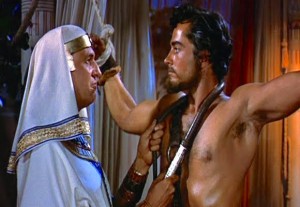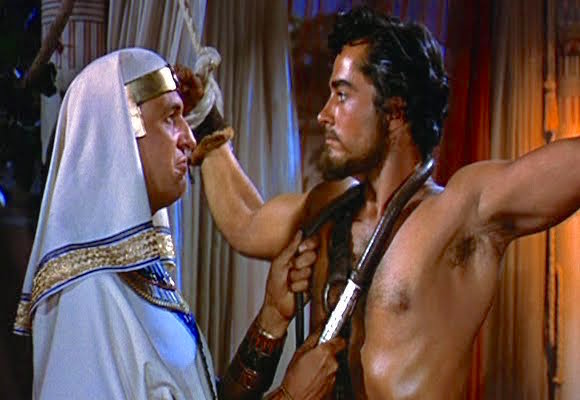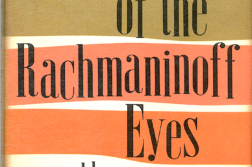A STORY often repeated in film history places Groucho Marx at the premiere of the 1949 Cecil B. DeMille epic Samson and Delilah. Posters of the massive, bare-chested Victor Mature served as the visual backdrop for anyone entering the theater that evening. After the movie’s debut, DeMille asked Groucho what he thought of the film. Groucho replied: “No picture can hold my interest where the leading man’s tits are bigger than the leading lady’s.”
The quotation is more than just a quip: it reveals something about the discomfort that the biblical epic engendered in the heterosexual male. Lured by the promise of Hedy Lamarr in the most diaphanous of costumes (a design of the great Edith Head), a straight man watching Samson and Delilah would be confronted with 128 minutes of an almost naked Victor Mature.
If, as Laura Mulvey proposed in her essay, “Visual Pleasure and Narrative Cinema,” the standard Hollywood “gaze” is heterosexual male, directed toward the gazed-upon female, then the genre of the biblical epic poses a peculiar—one might even say a queer—problem. In the biblical epic, the body of the male, stripped to a loincloth or clad in muscular but decidedly short-skirted armor, is as gazed upon as an object of desire. The prospect of an audience’s archetypal male gaze staring at the muscular bodies of Victor Mature, Charlton Heston, or Yul Brynner suffuses these films with homoeroticism—a decidedly gay male gaze. Furthermore, once the heterosexual, male-oriented machinery of the gaze is broken, it frees up the possibility of a female gaze as well—directed at the beefy male specimens on the screen, or at the delicious lesbian-femme fantasies of Hedy Lamarr, Anne Baxter, and Gina Lollobrigida.
Some of the queer subtext of biblical epics comes not from the sexual desirability of the main characters but from the films’ camp æsthetic. Camp, a sensibility of theatricality taken to extremes—sometimes knowingly, sometimes not—has long been a reading strategy of queer audiences. It takes an audience with an eye for the decadent and a gift for seeing double meaning to understand the subversive possibilities of a film like DeMille’s The Ten Commandments of 1959. The picture claims to be a straight-ahead portrayal of the Exodus story, yet contains a love triangle between Moses (Charlton Heston), Rameses (Yul Brynner) and Princess Nefretiri (Anne Baxter). Whatever the excesses of contemporary translations of the Bible, one could search the Scriptures endlessly without finding a reference for Nefretiri’s line to Moses in the film: “Oh Moses, Moses, you stubborn, splendid, adorable fool!” Or, referring to Moses’ encounter with God on Mount Sinai: “I don’t believe it’s only the thunder of a mountain that stirs your heart!”

Within The Ten Commandments, there are also characters that fit the camp mold often associated with gay men. One example is the master builder Baka, played by Vincent Price. A villain in the story, Price plays Baka as a camp virtuoso, one with a refined understanding of the arts of cosmetics, decoration, and fashion. When he kidnaps the lovely Lilia, a Hebrew slave girl played by Debra Paget, and takes her back to his palace, we fear for her virtue. We needn’t have. His first act after kidnapping this beautiful girl is to place her on a pedestal and begin dressing her in a fabulous gown. Baka is clearly familiar with the finer points of fabrics and textiles, asking her: “Did you know, my dear, this golden web was spun from the beards of shellfish?” And he corrects the women dressing Lilia as they drape a red scarf over her: “No, no, no, no, no! Not red with the samule gown.”
It is at this point that the lovely Lilia is rescued by her boyfriend, Joshua, the young, strapping stonecutter played by John Derek. Baka captures Joshua and soon has the shirtless slave strung up, ready to whip him in a blatant display of S&M villainy. Baka sensuously places the whip over Joshua’s neck, and, examining the bulbous tip of the whip’s handle, says: “You’ve seen me drive my chariot. I can pick a fly from my horse’s ear without breaking the rhythm of his stride.” Baka is a queer character: he enjoys dressing beautiful women in gowns he just happens to have lying around his palace, and likes tying up shirtless men and whipping them. But in 1950s Hollywood, queer characters often paid the price for their deviance. Just as Baka begins whipping Joshua, Moses breaks into the palace, subdues Baka, and strangles him with his own whip.
Baka’s ignominious end gets at the purpose of camp and queer characters in biblical films. There must be something un-holy for holy men and women to stand against. The flint that sparks the fire of God in epic films is the decadence of the ancient world, broadly drawn with orgies, sacrifices to idols, and the heaving bosoms of both women and men with their suggestions of gender and sexual variation. This sense of violent and sexual spectacle is exactly what viewers have expected from biblical films from the earliest silent melodramas to modern-day special-effects blockbusters.
In other words, the subversive secret of the queer and camp elements of biblical epics is that they are what make a film seem biblical. The great pageant of ancient history calls for men of superhuman strength and women of blinding beauty. The Hebrew and Christian peoples, with their stately laws and loyalty to one God, must be set apart and purified from the depravity of the world around them. But there’s no need to hurry. Before Moses comes down from the mountain, there can be plenty of debauchery at the altar of the golden calf.
Richard Lindsay is the author of Hollywood Biblical Epics: Camp Spectacle and Queer Style from the Silent Era to the Modern Day (Praeger), which was reviewed by Andrew Holleran in the Nov.-Dec. 2015 issue.





